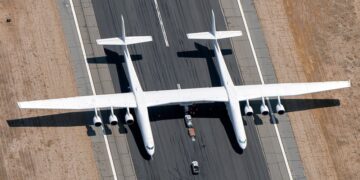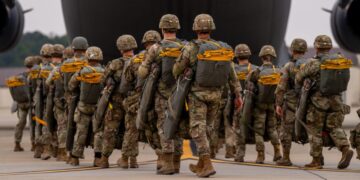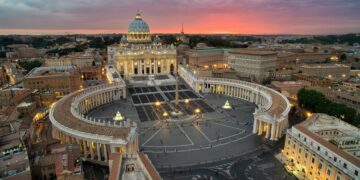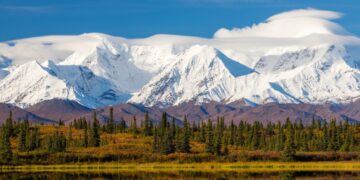A choke point refers to a strategic location, such as a narrow passage or a point of entry, where the control or disruption of movement can have significant implications for military, economic, or geopolitical reasons. These locations often serve as bottlenecks or critical junctions through which the majority of transportation, trade, or military traffic must pass, making them vulnerable to geopolitical tensions, piracy, and other security threats. Choke points can occur in both maritime and terrestrial environments.
- In a maritime context, choke points are narrow waterways that are crucial for maritime navigation and trade. They are often characterized by their limited width and are essential for connecting larger bodies of water. Examples include straits, canals, or channels that facilitate the movement of ships between oceans or seas.
- On land, choke points can be geographic features such as mountain passes, valleys, or key junctions that control access to certain areas. These locations are strategically important for military campaigns, trade routes, or transportation networks.
The significance of choke points lies in their vulnerability to control or disruption. If a nation or entity can exert influence or control over a choke point, it can potentially regulate or restrict the movement of goods, people, or military assets, thereby impacting regional or global dynamics. Consequently, choke points often become focal points for geopolitical competition, and tensions in these areas can have far-reaching consequences for international relations, security, and commerce.
Here are the key global choke points.
1. Strait of Hormuz
The Strait of Hormuz is a strait between the Persian Gulf and the Gulf of Oman. It provides the only sea passage from the Persian Gulf to the open ocean and is one of the world’s most strategically important choke points. On the north coast lies Iran, and on the south coast lies the Musandam peninsula, shared by the United Arab Emirates and the Musandam Governorate, an exclave of Oman.
The strait is about 90 nautical miles (167 km) long, with a width varying from about 52 nmi (96 km) to 21 nmi (39 km). A third of the world’s liquefied natural gas and almost 25% of total global oil consumption passes through the strait, making it a highly important strategic location for international trade. It has been so for centuries; its vast hinterlands were rich in luxury trade goods with no easy access to lucrative trading ports.
2. Bab-el-Mandeb
The Bab-el-Mandeb is a strait between Yemen on the Arabian Peninsula and Djibouti and Eritrea in the Horn of Africa. It connects the Red Sea to the Gulf of Aden and by extension the Indian Ocean. The strait derives its name from the dangers attending its navigation or, according to an Arab legend, from the numbers who were drowned by an earthquake that separated the Arabian Peninsula from the Horn of Africa.
The distance across is about 26 kilometres (16 mi) from Ras Menheli in Yemen to Ras Siyyan in Djibouti. The Bab el-Mandeb Strait is 18 miles wide at its narrowest point, limiting tanker traffic to two 2-mile-wide channels for inbound and outbound shipments. The Bab-el-Mandeb acts as a strategic link between the Indian Ocean and the Mediterranean Sea via the Red Sea and the Suez Canal.
3. Strait of Malacca
Malacca Strait is a narrow stretch of water, 500 mi (800 km) long and from 40 to 155 mi (65–250 km) wide, located between the Indonesian island of Sumatra to the southwest and the Malay Peninsula (Peninsular Malaysia) to the northeast, connecting the Andaman Sea (Indian Ocean) with the Singapore Strait and the South China Sea (Pacific Ocean) As the main shipping channel between the Indian Ocean and South China Sea, it is one of the most important shipping lanes in the world. It is named after the Phyllanthus emblica, which known by the locals as the Malaka tree, grown in coastal regions alongside the strait.
4. Panama Canal
The Panama Canal is an artificial 82-kilometre (51-mile) waterway in Panama that connects the Atlantic Ocean with the Pacific Ocean, cutting across the Isthmus of Panama, and is a conduit for maritime trade. Canal locks at each end lift ships up to Gatun Lake, an artificial freshwater lake 26 meters (85 ft) above sea level, created by damming up the Chagres River and Lake Alajuela to reduce the amount of excavation work required for the canal, and then lower the ships at the other end.
An average of 200,000,000 L (52,000,000 US gal) of fresh water are used in a single passing of a ship. The Panama Canal shortcut greatly reduces the time for ships to travel between the Atlantic and Pacific oceans, enabling them to avoid the lengthy, hazardous route around the southernmost tip of South America via the Drake Passage or Strait of Magellan. It is one of the largest and most difficult engineering projects ever undertaken.
5. Suez Canal
The Suez Canal is an artificial sea-level waterway in Egypt, connecting the Mediterranean Sea to the Red Sea through the Isthmus of Suez and dividing Africa and Asia (and by extension, the Sinai Peninsula from the rest of Egypt). The 193.30-kilometre-long (120.11 mi) canal is a key trade route between Europe and Asia. It offers vessels a direct route between the North Atlantic and northern Indian oceans via the Mediterranean Sea and the Red Sea, avoiding the South Atlantic and southern Indian oceans.
The canal reduces the journey distance from the Arabian Sea to London by approximately 8,900 kilometres (5,500 mi), to 10 days at 20 knots (37 km/h; 23 mph) or 8 days at 24 knots (44 km/h; 28 mph). The canal extends from the northern terminus of Port Said to the southern terminus of Port Tewfik at the city of Suez. The canal has played an important military strategic role as a naval short-cut and choke point. Navies with coastlines and bases on both the Mediterranean Sea and the Red Sea (Egypt and Israel) have a particular interest in the Suez Canal.
6. Strait of Gibraltar
The Strait of Gibraltar is a narrow strait that connects the Atlantic Ocean to the Mediterranean Sea and separates Europe from Africa. The two continents are separated by 13 kilometres (8.1 miles; 7.0 nautical miles) of ocean at the Strait’s narrowest point between Point Marroquí in Spain and Point Cires in Morocco. The strait lies in the territorial waters of Morocco, Spain, and the British overseas territory of Gibraltar.
7. Strait of Dover
The Strait of Dover or Dover Strait is the strait at the narrowest part of the English Channel, marking the boundary between the Channel and the North Sea, and separating Great Britain from continental Europe. The shortest distance across the strait, at approximately 20 miles (32 kilometres), is from the South Foreland, northeast of Dover in the English county of Kent, to Cap Gris Nez, a cape near to Calais in the French département of Pas-de-Calais. The entire strait is within the territorial waters of France and the United Kingdom.
8. Strait of Magellan
The Strait of Magellan, also called the Straits of Magellan, is a navigable sea route in southern Chile separating mainland South America to the north and Tierra del Fuego to the south. The strait is considered the most important natural passage between the Atlantic and Pacific oceans. The strait is approximately 570 km (310 nmi; 350 mi) long and 2 km (1.1 nmi; 1.2 mi) wide at its narrowest point.
In 1520, the Spanish expedition of Ferdinand Magellan, after whom the strait is named, became the first Europeans to discover it. The route is difficult to navigate due to frequent narrows and unpredictable winds and currents. Maritime piloting is now compulsory. The strait is shorter and more sheltered than the Drake Passage, the often stormy open sea route around Cape Horn, which is beset by frequent gale-force winds and icebergs.
9. Beagle Channel
Beagle Channel is a strait in the Tierra del Fuego Archipelago, on the extreme southern tip of South America between Chile and Argentina. The channel separates the larger main island of Isla Grande de Tierra del Fuego from various smaller islands including the islands of Picton, Lennox and Nueva; Navarino; Hoste; Londonderry; and Stewart. The channel’s eastern area forms part of the border between Chile and Argentina and the western area is entirely within Chile.
The Beagle Channel, the Straits of Magellan to the north, and the open-ocean Drake Passage to the south are the three navigable passages around South America between the Pacific and Atlantic Oceans. Most commercial shipping uses the open-ocean Drake Passage. The Beagle Channel is about 240 kilometres (130 nmi; 150 mi) long and 5 kilometres (3 nmi; 3 mi) wide at its narrowest point. It extends from Nueva Island in the east to Darwin Sound and Cook Bay in the Pacific Ocean in the west.
10. Drake Passage
The Drake Passage is the body of water between South America’s Cape Horn, Chile, Argentina and the South Shetland Islands of Antarctica. It connects the southwestern part of the Atlantic Ocean (Scotia Sea) with the southeastern part of the Pacific Ocean and extends into the Southern Ocean. The passage is named after the 16th-century English explorer and privateer Sir Francis Drake. The Drake Passage is considered one of the most treacherous voyages for ships to make.
Currents at its latitude meet no resistance from any landmass, and waves top 40 feet (12 m), giving it a reputation for being “the most powerful convergence of seas”. As the Drake Passage is the narrowest passage (choke point) around Antarctica, its existence and shape strongly influence the circulation of water around Antarctica and the global oceanic circulation, as well as the global climate. The bathymetry of the Drake Passage plays an important role in the global mixing of oceanic water.
11. Cape of Good Hope
The Cape of Good Hope is a rocky headland on the Atlantic coast of the Cape Peninsula in South Africa. When following the western side of the African coastline from the equator, however, the Cape of Good Hope marks the point where a ship begins to travel more eastward than southward. As one of the great capes of the South Atlantic Ocean, it has long been of special significance to sailors. The Cape of Good Hope is often used as an alternative route to the Suez Canal, for ships needing a different route from the Indian Ocean.
12. Bering Strait
The Bering Strait is a strait between the Pacific and Arctic oceans, separating the Chukchi Peninsula of the Russian Far East from the Seward Peninsula of Alaska. The Bering Strait is about 82 kilometers (51 mi) wide at its narrowest point, between Cape Dezhnev, Chukchi Peninsula, Russia, the easternmost point of the Asian continent and Cape Prince of Wales, Alaska, United States, the westernmost point of the North American continent. The Strait is named after Vitus Bering, a Danish explorer in the service of the Russian Empire.
13. Bosphorus Strait
The Bosporus or Bosphorus Strait is a natural strait and an internationally significant waterway located in Istanbul, Turkey. The Bosporus connects the Black Sea to the Sea of Marmara and forms one of the continental boundaries between Asia and Europe. It also divides Turkey by separating Anatolia from Thrace. It is the world’s narrowest strait used for international navigation. The Bosporus Strait and the Dardanelles Strait at the opposite end of the Sea of Marmara are together known as the Turkish Straits.
14. Dardanelles Strait
The Dardanelles, also known as the Strait of Gallipoli (after the Gallipoli peninsula) and in Classical Antiquity as the Hellespont, is a narrow, natural strait and internationally significant waterway in northwestern Turkey that forms part of the continental boundary between Asia and Europe and separates Asian Turkey from European Turkey. Together with the Bosporus, the Dardanelles forms the Turkish Straits.
One of the world’s narrowest straits used for international navigation, the Dardanelles connects the Sea of Marmara with the Aegean and Mediterranean seas while also allowing passage to the Black Sea by extension via the Bosporus. The Dardanelles is 61 kilometres (38 mi) long and 1.2 to 6 kilometres (0.75 to 3.73 mi) wide. It has an average depth of 55 metres (180 ft) with a maximum depth of 103 metres (338 ft) at its narrowest point abreast the city of Çanakkale.
15. Strait of Tartary
Strait of Tartary or Gulf of Tartary is a strait in the Pacific Ocean dividing the Russian island of Sakhalin from mainland Asia (South-East Russia), connecting the Sea of Okhotsk (Nevelskoy Strait) on the north with the Sea of Japan on the south. It is 632 kilometres (393 mi) long, 7-342 kilometres (4.3-212.5 mi) wide, and less than 210 m (690 ft) deep at its deepest point.
16. Khyber Pass
The Khyber Pass is a mountain pass in the Khyber Pakhtunkhwa province of Pakistan, on the border with the Nangarhar Province of Afghanistan. It connects the town of Landi Kotal to the Valley of Peshawar at Jamrud by traversing part of the White Mountains. Since it was part of the ancient Silk Road, it has been a vital trade route between Central Asia and the Indian subcontinent and a strategic military choke point for various states that controlled it. The Khyber Pass is considered one of the most famous mountain passes in the world.
Conclusion
The geopolitical importance of these choke points cannot be overstated. These narrow passages are the lifeblood of global trade, and any disruptions or tensions/conflicts in these regions often have far-reaching consequences, affecting the stability of global markets, energy prices, and the overall geopolitical landscape. Countries with control or influence over these strategic passages can wield significant power and leverage in global affairs. Efforts to ensure the security and stability of these critical passages are essential for maintaining the smooth flow of goods and resources in the international arena.
































































































































































































